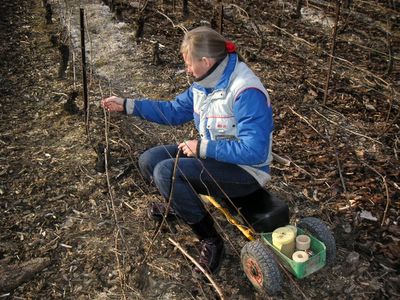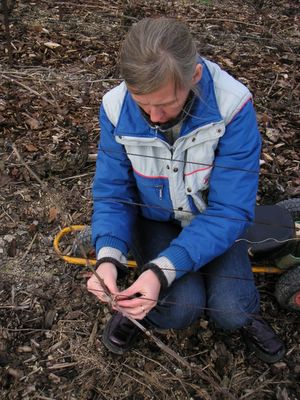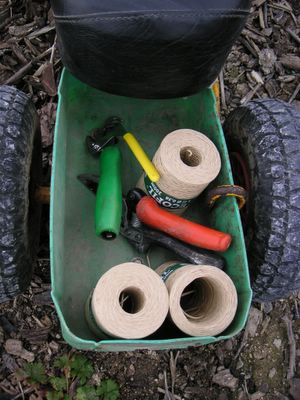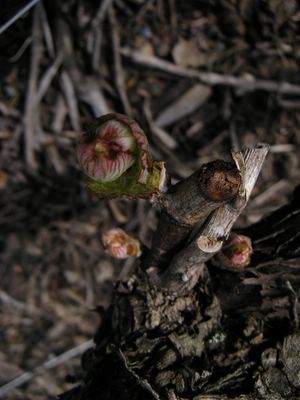 Ladies and gentlemen, let's attach.
Ladies and gentlemen, let's attach.The long and laborious pruning of the winter is over, and we are just about to finish rolling through the rows on the next manpower demanding task in the vineyard: Attaching the wine.
The attentive reader with a good memory may still remember that the wine - if it like ours have been pruned in the Vallée de la Marne way - after this rather exhaustive shave now consists of only two branches and a little bit, that does not interest us now. These are the leftovers that now are to be attached to the wires. Vintage 2005 is on the move, and the ride takes place in a rather peculiar vehicle.
On a low but sturdy little bench on heavy wheels you move from plant to plant. Your advantage is that you do not have to consider other ways of working such as crawl on your knees or bending up and down all the time in front of the 1,2 meters tall - or should I rather say low - ironposts, that carry the wires of the wine. However, you must be prepared to bring your chariot back on the track regularly.
 The steering system of the chariot is rather poor, but it is well upholstered and the heavy wheels easily force their way through wood chip, even uphill.
The steering system of the chariot is rather poor, but it is well upholstered and the heavy wheels easily force their way through wood chip, even uphill.Conveniantly seated on the upholstered bench of the chariot you stop in front of the wine, while you catch one or the other of the two branches. On the old branch the outermost of last years new branches has survived in a length of eight buds. The other and new branch is just long enough not to bother the old one, when they both in a short while will be attached to the bottom row of metal thread. A task, that contributes to the general order of the vineyard.
Ingenious inventionA wine is a liana - a plant that wants to climb - and it will grow in all directions and angles, while looking for something to attach itself to. This is why the vineyard is furnished with ironposts with kilometres and more kilometres of metal thread retained between them. This is where the well pruned wine will be attached in the first part of April, just before the wine begins its growth again.
Three attachments per plant are enough for the Pinot Meunier. For the other types -the Chardonnay and Pinot Noir - the attachment as well as the pruning is slightly different. Meunier needs one attachment for the old branch, another one for its young branch and the third and last one for the new branch. If you need more, you are not good enough... yet. At least that is our rule, checking the work of the neighbours I can see, that the number varies a lot. Even I try to do only three attachments per plant, I count myself really lucky not to work on the official piecework in the business: 90 hours per hectare. We have around five kilometres of wine to deal with, and that adds up to only 2/3 of a hectare.
 The old branch is attached. The hook of the lieuse is ready in the loop.
The old branch is attached. The hook of the lieuse is ready in the loop. The principle is rather simple. You put a piece of string around your branch and the lower thread. Then you place the hook from the special tool that you use for attaching -
la lieuse - in your loop and pull all the way through. Backwards. A movement, where you move your arm 20-30 centimetres backwards and a lot longer than you expect is necessary.
The string you use consists of wire with a layer of paper around it. This you can tie up with a twist, when you use the
lieuse. Yet another of the many very specialized tools of this metier. The tool has two parts: One with a hook, that more than anything has a similarity with a small hand drill, and the other one, that resembles the part of a three-in-one cutter for your nails.
You typically begin with the old branch, continue with its young branch and finish with the independant young branch. This is the time you will know if you made the right choices as you did the pruning.
 The cutter to the left
The cutter to the left.
Exercising the wineThe old branch is by far the more easy one for a beginner. You will tie it up where it meets the lower thread in a angle around 90 degrees. This means you just tie straight away, you normally do not have to force it in any direction against its natural growth.
Worse with the two next branches of last year. They are young and actually rather bendable, so it should not cause major problems to bend them 90 degrees against their natural inclination without breaking them. But you better believe that you are right as you carefully press the vertical branch down in a more and more horizontal position, that makes it crush worse and worse. When you have finished your job, the branch is either broken or it follows a rather parallel line along the wire. This is when you can put your second or third attachment.
If you end up with more than one bud over the wires, you cut it off. You simply never pay your vineyard a visit without the proper tool, so always carry your scissors for pruning. This time of year a clip will make the latex flow. It does not cause problems though, as long as you do not get frost the following night.
 Concentration please: No broken branches. No loose attachments and preferably in a steady beat.
Concentration please: No broken branches. No loose attachments and preferably in a steady beat.Here and there the layer of bark creak in an unpleasant way, while you check your will against that of the branch. But even if cracks here and there reveal a light green layer under the brown, normally only branches with disease will break.
Now is the time, where you will be confronted with wrong decisions made during the period of pruning. Diseased or weak branches that should have been rejected but were not will break. It does not influence the amount of grapes, because the new part of the old branch normally will be healthy and this is where the grapes are produced. However, if the other young branch breaks, it means, that the renewal of the plant will be postponed yet another year. The old one must fight itself through another year on its own. Just like in real life.
 In the little box on your chariot you carry everything you need to get going for the liage: Your string, your lieuse and your scissors.
In the little box on your chariot you carry everything you need to get going for the liage: Your string, your lieuse and your scissors. Old attachments will stay forever.På dansk
Old attachments will stay forever.På dansk










